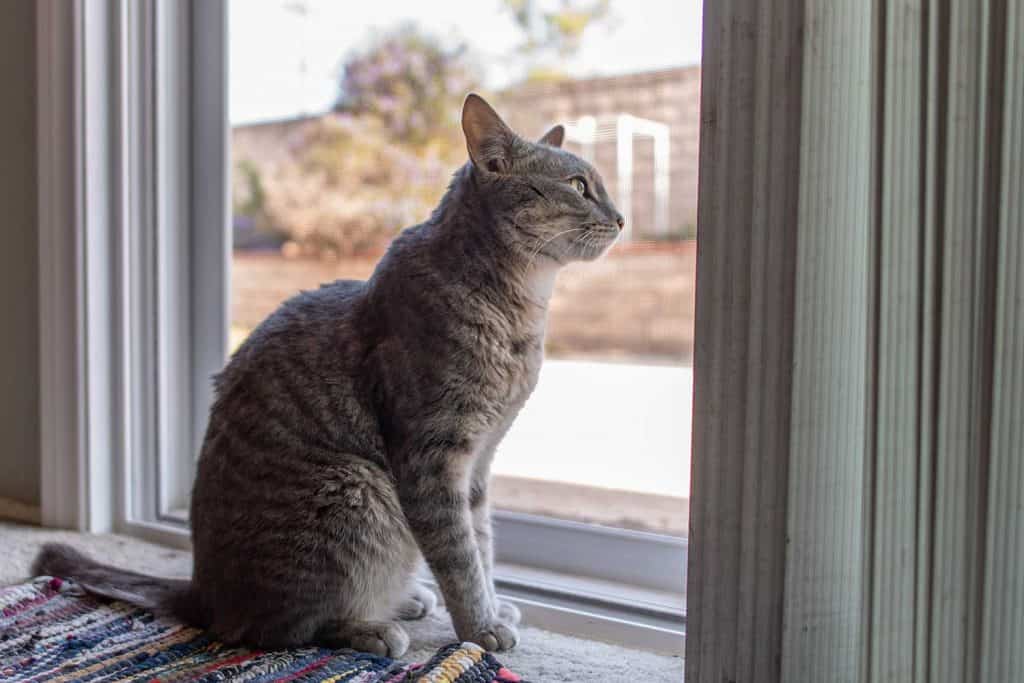Are you looking for your cats, only to find out that they went out by opening the screen door? Your household felines are smarter than you might think. Your pets can open screen doors by nudging the entryways with their paws. Once an opening is within sight, your cats are off to explore the outside world. So how do you keep cats from opening a screen door? We asked the experts and here's what they say.
You can apply different techniques to keep your cats from opening a screen door. Some cats will try to figure out different ways to go outside. But the following methods can help you keep them inside your home:
- Apply a scratch deterrent on the door.
- Block the door with a large and bulky object.
- Entice the cats with scratching posts.
- Trim their claws.
Continue reading because we have more information to discuss with you about cats and how you can stop them from going outside through screen doors. We’ll also tackle other relevant topics, such as the steps to install a screen door guard.

Taking Your Cats' Focus Off Screen Doors
Some cats see screen doors as challenges they have to win. These entryways are barriers that prevent your pets from enjoying the great outdoors. It also means, however, that your screen doors are likely to incur damage to your pets. Your felines might be in danger to things like wild, aggressive animals, and even pet thieves.

Use the following steps to divert their attention and stop your cats from opening screen doors as well as keep them safe indoors:
Use a Scratch Deterrent
Cats don’t like certain smells, and you can use that to your advantage to keep them away from going near screen doors. An article from the Massachusetts Society for the Prevention of Cruelty to Animals (MSPCA) confirms that many felines don’t like the smell of citrus, aloe, citronella, eucalyptus, and wintergreen.
Make a spray from these scents to deter your pets from trying to scratch open screen doors. Here are the steps to create this solution:
- Prepare an empty spray bottle and fill it with about eight ounces of lukewarm water.
- Add a few drops of essential oils with the smells that cats tend to hate as mentioned above.
- Mix the liquids by shaking or stirring the spray bottle.
- Spray the screen door once a day.
Aside from using a spray bottle, you can also put the scratch deterrent solution in a diffuser. However, make sure to keep it away from other appliances to prevent short circuits.
Check out this Bodhi Cat & Kitten Training Spray on Amazon.
Block the Door
Find a reasonably large box and fill it with fairly heavy items. Then, block your screen door with the container to prevent your cat from going near the screen door.
Take note that this technique might not be for everyone, especially after seeing an oddly-placed box near your screen door. Still, if you don’t like using a box, you can also use other items to block your pet from attempting to open the door. For example, you may use a large piece of wood or a piece of low-extending furniture for this purpose.
With the large and heavy object blocking the door, your household feline won’t likely get to the screen door to scratch it. Also, the item will prevent the door from being pried open, which can be effective for entryways that don't close flush.
Entice with Scratching Posts
According to The Humane Society of the United States, cat scratching is normal, instinctive behavior. The animal does this action to express certain feelings, such as enthusiasm or stress. But it can also lead to destructive behavior if not controlled, which means that you’ll eventually see holes in your screen door.
You can’t stop a cat from scratching, but you can lead your pet away from the screen door with the help of a scratching post. Entice your feline to scratch the post with some catnip. Spray some catnip leaves on the scratching post or hang a catnip toy on it.
Make sure to watch your pet during this activity because cats can get bored with catnip after more than a few minutes of use. If you don’t remove the catnip, it becomes tougher to entice your pet with the substance over time.
Take a look at this scratching post on Amazon.
Trim the Claws
You can prevent getting holes on your screen doors by trimming your cat’s claws. But make sure to trim the claws at a reasonable level. Cutting too much of a claw can lead to bleeding, which can increase the risks of your pet contracting illnesses from infections.
Here are the steps to trim your cat’s claws safely:
- Lay your cat on their side. You can also place the animal on your lap.
- Search for the pink, fleshy area of the claw.
- Cut the white part of the claw with a reliable cat nail clipper. Avoid the pink area at all costs.
- If you accidentally cut a portion of the pink area, dab it quickly with a bit of styptic powder to help stop the bleeding.
Can a Cat Get Through a Screen Door?

Regular screen doors are reasonably easy to rip open with a cat’s sharp claws. But you can replace the conventional screen door with a pet-proof model. A door with a sturdy fiberglass or aluminum mesh can be a great option. Make sure to clean these doors frequently to preserve their durability. Otherwise, your cat’s claws may still rip these materials open if they weaken.
Check this Saint-Gobain pet-resistant screen door repair kit on Amazon.
How do You Cat-Proof a Screen Door?
Aside from the methods discussed in the previous section, you can cat-proof a screen door through proper training.
Train your pet to stop scratching your screen door by loosely filling a metal container with some coins. Then, shake the container whenever your cat attempts to scratch the door. Over time, the animal will associate scratching the screen door with the surprising sound, thus, preventing the destructive action.
Will a Magnetic Screen Door Keep a Cat In?

Yes, a magnetic screen door can keep a cat indoors. But you need to pay attention to the material of the mesh. If the mesh isn't pet-proof, your feline can still claw its way outside. Fiberglass mesh can be a good option, albeit the material can be quite difficult to cut to the right size without the proper tools. Purchase and install a magnetic screen door with a durable mesh to ensure your pet stays inside.
How Do You Install a Screen Door Guard?
You can follow the instructions that generally come with many screen door guards for a proper installation. Still, here’s a quick step-by-step guide on how to install this particular product correctly:
- Mark with a pencil the areas where the screen’s brackets will go on the door.
- Align the guard on the screen door. Use clamps to ensure that the guard stays in place. Make sure that the clamps don’t cover the holes.
- Use a drill with an appropriate drill bit to create holes on the marks.
- Install the screws, and the guard should be now stable and secure on the door.
Look at this Safety 1st screen door guard on Amazon.
Final Words
Cats can pry or scratch open screen doors if you don’t take the necessary precautions. You can prevent these issues by using scratch deterrents, enticing your cat with scratching posts, trimming your cat’s claws, or blocking your doors with large objects. Use appropriate, pet-friendly methods, and your screen doors will be safe from your cats’ claws.







